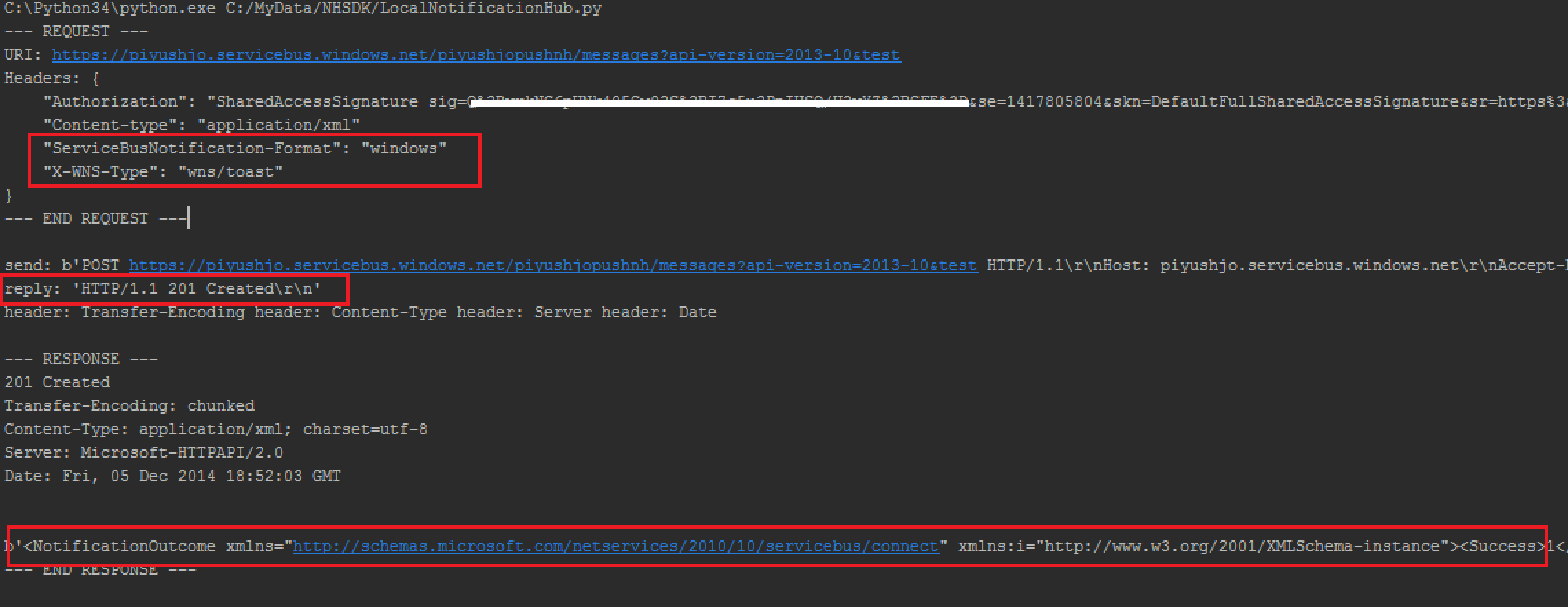如何透過 Python 使用通知中樞
您可以使用通知中樞 REST 介面,透過 Java/PHP/Python/Ruby 後端來存取所有通知中樞功能,如 MSDN 文章通知中樞 REST API所述。
注意
這是在 Python 實作通知傳送的範例參考實作,並非正式支援的通知中樞 Python SDK。 此範例是使用 Python 3.4 建立的。
本文示範如何:
- 在 Python 中建置通知中樞功能的 REST 用戶端。
- 使用 Python 介面傳送通知到通知中樞 REST API。
- 取得 HTTP REST 要求/回應的傾印以用於偵錯/教學用途。
您可以遵循選定行動平台的 開始使用教學課程 來實作 Python 的後端部分。
注意
此範例的範圍僅限於傳送通知,不會執行任何註冊管理。
用戶端介面
主要用戶端介面提供的方法與 .NET 通知中樞 SDK中的方法相同。 這個介面可讓您直接轉換此網站目前所提供,以及由網際網路社群所貢獻的所有教學課程和範例。
您可在 Python REST 包裝函式範例中找到所有可用的程式碼。
例如,若要建立用戶端:
isDebug = True
hub = NotificationHub("myConnectionString", "myNotificationHubName", isDebug)
傳送 Windows 快顯通知:
wns_payload = """<toast><visual><binding template=\"ToastText01\"><text id=\"1\">Hello world!</text></binding></visual></toast>"""
hub.send_windows_notification(wns_payload)
實作
如果尚未這麼做,請遵循開始使用教學課程中的指示,一路進行到您必須實作後端的最後一節。
您可以在 MSDN上找到所有實作完整 REST 包裝函式的詳細資料。 本節將針對存取通知中樞 REST 端點和傳送通知所需主要步驟的 Python 實作進行說明
- 解析連接字串
- 產生授權權杖
- 使用 HTTP REST API 傳送通知
解析連接字串
以下是實作其建構函式可解析連接字串之用戶端的主要類別:
class NotificationHub:
API_VERSION = "?api-version=2013-10"
DEBUG_SEND = "&test"
def __init__(self, connection_string=None, hub_name=None, debug=0):
self.HubName = hub_name
self.Debug = debug
# Parse connection string
parts = connection_string.split(';')
if len(parts) != 3:
raise Exception("Invalid ConnectionString.")
for part in parts:
if part.startswith('Endpoint'):
self.Endpoint = 'https' + part[11:].lower()
if part.startswith('SharedAccessKeyName'):
self.SasKeyName = part[20:]
if part.startswith('SharedAccessKey'):
self.SasKeyValue = part[16:]
建立安全性權杖
您可以在 此處找到建立安全性權杖的詳細資料。
將下列方法新增至 NotificationHub 類別,以依據目前要求的 URI,以及從連接字串擷取的認證來建立權杖。
@staticmethod
def get_expiry():
# By default returns an expiration of 5 minutes (=300 seconds) from now
return int(round(time.time() + 300))
@staticmethod
def encode_base64(data):
return base64.b64encode(data)
def sign_string(self, to_sign):
key = self.SasKeyValue.encode('utf-8')
to_sign = to_sign.encode('utf-8')
signed_hmac_sha256 = hmac.HMAC(key, to_sign, hashlib.sha256)
digest = signed_hmac_sha256.digest()
encoded_digest = self.encode_base64(digest)
return encoded_digest
def generate_sas_token(self):
target_uri = self.Endpoint + self.HubName
my_uri = urllib.parse.quote(target_uri, '').lower()
expiry = str(self.get_expiry())
to_sign = my_uri + '\n' + expiry
signature = urllib.parse.quote(self.sign_string(to_sign))
auth_format = 'SharedAccessSignature sig={0}&se={1}&skn={2}&sr={3}'
sas_token = auth_format.format(signature, expiry, self.SasKeyName, my_uri)
return sas_token
使用 HTTP REST API 傳送通知
注意
Microsoft 推播通知服務 (MPNS) 已經淘汰且不再支援。
首先,讓我們先定義呈現通知的類別。
class Notification:
def __init__(self, notification_format=None, payload=None, debug=0):
valid_formats = ['template', 'apple', 'gcm',
'windows', 'windowsphone', "adm", "baidu"]
if not any(x in notification_format for x in valid_formats):
raise Exception(
"Invalid Notification format. " +
"Must be one of the following - 'template', 'apple', 'gcm', 'windows', 'windowsphone', 'adm', 'baidu'")
self.format = notification_format
self.payload = payload
# array with keynames for headers
# Note: Some headers are mandatory: Windows: X-WNS-Type, WindowsPhone: X-NotificationType
# Note: For Apple you can set Expiry with header: ServiceBusNotification-ApnsExpiry
# in W3C DTF, YYYY-MM-DDThh:mmTZD (for example, 1997-07-16T19:20+01:00).
self.headers = None
此類別是範本通知的原生通知主體或一組屬性的容器;為標頭集合,其包含格式 (原生平台或範本),以及平台特定屬性 (如 Apple 到期屬性和 WNS 標頭)。
請參閱通知中樞 REST API 文件及特定通知平台的格式,以取得所有可用選項。
透過此類別,現在可以在 NotificationHub 類別內寫入傳送通知方法。
def make_http_request(self, url, payload, headers):
parsed_url = urllib.parse.urlparse(url)
connection = http.client.HTTPSConnection(
parsed_url.hostname, parsed_url.port)
if self.Debug > 0:
connection.set_debuglevel(self.Debug)
# adding this querystring parameter gets detailed information about the PNS send notification outcome
url += self.DEBUG_SEND
print("--- REQUEST ---")
print("URI: " + url)
print("Headers: " + json.dumps(headers, sort_keys=True,
indent=4, separators=(' ', ': ')))
print("--- END REQUEST ---\n")
connection.request('POST', url, payload, headers)
response = connection.getresponse()
if self.Debug > 0:
# print out detailed response information for debugging purpose
print("\n\n--- RESPONSE ---")
print(str(response.status) + " " + response.reason)
print(response.msg)
print(response.read())
print("--- END RESPONSE ---")
elif response.status != 201:
# Successful outcome of send message is HTTP 201 - Created
raise Exception(
"Error sending notification. Received HTTP code " + str(response.status) + " " + response.reason)
connection.close()
def send_notification(self, notification, tag_or_tag_expression=None):
url = self.Endpoint + self.HubName + '/messages' + self.API_VERSION
json_platforms = ['template', 'apple', 'gcm', 'adm', 'baidu']
if any(x in notification.format for x in json_platforms):
content_type = "application/json"
payload_to_send = json.dumps(notification.payload)
else:
content_type = "application/xml"
payload_to_send = notification.payload
headers = {
'Content-type': content_type,
'Authorization': self.generate_sas_token(),
'ServiceBusNotification-Format': notification.format
}
if isinstance(tag_or_tag_expression, set):
tag_list = ' || '.join(tag_or_tag_expression)
else:
tag_list = tag_or_tag_expression
# add the tags/tag expressions to the headers collection
if tag_list != "":
headers.update({'ServiceBusNotification-Tags': tag_list})
# add any custom headers to the headers collection that the user may have added
if notification.headers is not None:
headers.update(notification.headers)
self.make_http_request(url, payload_to_send, headers)
def send_apple_notification(self, payload, tags=""):
nh = Notification("apple", payload)
self.send_notification(nh, tags)
def send_google_notification(self, payload, tags=""):
nh = Notification("gcm", payload)
self.send_notification(nh, tags)
def send_adm_notification(self, payload, tags=""):
nh = Notification("adm", payload)
self.send_notification(nh, tags)
def send_baidu_notification(self, payload, tags=""):
nh = Notification("baidu", payload)
self.send_notification(nh, tags)
def send_mpns_notification(self, payload, tags=""):
nh = Notification("windowsphone", payload)
if "<wp:Toast>" in payload:
nh.headers = {'X-WindowsPhone-Target': 'toast',
'X-NotificationClass': '2'}
elif "<wp:Tile>" in payload:
nh.headers = {'X-WindowsPhone-Target': 'tile',
'X-NotificationClass': '1'}
self.send_notification(nh, tags)
def send_windows_notification(self, payload, tags=""):
nh = Notification("windows", payload)
if "<toast>" in payload:
nh.headers = {'X-WNS-Type': 'wns/toast'}
elif "<tile>" in payload:
nh.headers = {'X-WNS-Type': 'wns/tile'}
elif "<badge>" in payload:
nh.headers = {'X-WNS-Type': 'wns/badge'}
self.send_notification(nh, tags)
def send_template_notification(self, properties, tags=""):
nh = Notification("template", properties)
self.send_notification(nh, tags)
這些方法會傳送 HTTP POST 要求至通知中樞的 /messages 端點,並使用正確的主體和標頭來傳送通知。
使用偵錯屬性啟用詳細的記錄
在初始化通知中樞時啟用偵錯屬性會寫出關於 HTTP 要求和回應傾印的詳細記錄資訊,以及詳細的通知訊息傳送結果。 通知中樞 TestSend 屬性 \(英文\) 會傳回關於通知傳送結果的詳細資訊。 若要使用它,請使用下列程式碼來初始化:
hub = NotificationHub("myConnectionString", "myNotificationHubName", isDebug)
通知中樞傳送要求 HTTP URL 會附加 "test" 查詢字串作為結果。
完成教學課程
現在您可以透過從 Python 後端傳送通知,來完成開始使用教學課程。
初始化您的通知中樞用戶端 (請依 開始使用教學課程中的指示替換連接字串和中心名稱):
hub = NotificationHub("myConnectionString", "myNotificationHubName")
然後根據您的目標行動平台新增傳送程式碼。 此範例也會新增更高層級的方法,以依據平台傳送通知,例如 send_windows_notification (適用於 Windows)、send_apple_notification (適用於 Apple) 等。
Windows 市集和 Windows Phone 8.1 (非 Silverlight)
wns_payload = """<toast><visual><binding template=\"ToastText01\"><text id=\"1\">Test</text></binding></visual></toast>"""
hub.send_windows_notification(wns_payload)
Windows Phone 8.0 和 8.1 Silverlight
hub.send_mpns_notification(toast)
iOS
alert_payload = {
'data':
{
'msg': 'Hello!'
}
}
hub.send_apple_notification(alert_payload)
Android
gcm_payload = {
'data':
{
'msg': 'Hello!'
}
}
hub.send_google_notification(gcm_payload)
Kindle Fire
adm_payload = {
'data':
{
'msg': 'Hello!'
}
}
hub.send_adm_notification(adm_payload)
Baidu
baidu_payload = {
'data':
{
'msg': 'Hello!'
}
}
hub.send_baidu_notification(baidu_payload)
執行 Python 程式碼應會產生一則顯示於目標裝置的通知。
範例
啟用 debug 屬性
若在初始化 NotificationHub 時啟用偵錯旗標,您會看到詳細的 HTTP 要求和回應傾印,還有類似以下的 NotificationOutcome,您可從中了解在要求中傳送的 HTTP 標頭,以及從通知中樞接收到的 HTTP 回應:

例如,您會看到詳細的通知中樞結果。
- 訊息成功傳送至推播通知服務的時間。
<Outcome>The Notification was successfully sent to the Push Notification System</Outcome> - 如果找不到任何推播通知的目標,您可能會看到下列輸出作為回應 (這表示找不到可傳遞通知的註冊,可能是因為註冊有一些不相符的標記)
'<NotificationOutcome xmlns="http://schemas.microsoft.com/netservices/2010/10/servicebus/connect" xmlns:i="https://www.w3.org/2001/XMLSchema-instance"><Success>0</Success><Failure>0</Failure><Results i:nil="true"/></NotificationOutcome>'
廣播快顯通知給 Windows
請注意當您傳送廣播快顯通知給 Windows 用戶端時所送出的標頭。
hub.send_windows_notification(wns_payload)

傳送指定標記 (或標記運算式) 的通知
請注意到新增至 HTTP 要求的 Tags HTTP 標頭 (在下列範例中,通知只會被傳送至含有 'sports' 承載的註冊)
hub.send_windows_notification(wns_payload, "sports")

傳送指定多個標記的通知
請注意傳送多個標記時的 Tags HTTP 標頭如何變更
tags = {'sports', 'politics'}
hub.send_windows_notification(wns_payload, tags)

樣板化通知
請注意,Format HTTP 標頭會變更,承載主體則會傳送為 HTTP 要求主體的一部分:
用戶端 - 註冊的範本:
var template = @"<toast><visual><binding template=""ToastText01""><text id=""1"">$(greeting_en)</text></binding></visual></toast>";
伺服器端 - 傳送承載:
template_payload = {'greeting_en': 'Hello', 'greeting_fr': 'Salut'}
hub.send_template_notification(template_payload)

後續步驟
本主題會說明如何針對通知中樞建立 Python REST 用戶端。 從這裡您可以:
- 下載完整的 Python REST 包裝函式範例,其中包含本文章的所有程式碼。
- 繼續了解 即時新聞教學課程
- 繼續了解 當地語系化新聞教學課程